The Internet of Things (IoT) is changing our daily lives, especially in smart home technology. It turns ordinary homes into smart, connected spaces. These spaces offer more convenience, efficiency, and better control over everything.1 We will explore IoT’s part in smart homes. We’ll look into how it functions, the tech behind it, and what’s next for home automation.
Key Takeaways
- IoT has revolutionized smart home technology, providing enhanced convenience, efficiency, and control.
- Smart home devices enable remote control, real-time monitoring, energy efficiency, and integrated entertainment systems.
- IoT in smart homes offers benefits such as convenience, enhanced security, energy efficiency, personalization, and improved accessibility.
- Challenges include data security, interoperability, and the initial cost of implementation.
- The future of IoT in smart homes includes AI integration, enhanced security, and improved interconnectivity.
Introduction to IoT in Smart Homes
The tech world turned simple houses into smart ones with IoT. This Internet of Things change how we live in our houses. It’s all about making our homes connected and intelligent. Let’s learn more about smart homes and how IoT fits into this new way of living.
What is a Smart Home?
A smart home is where internet devices help run everything. They let you watch over and control things like lights, heat, and security from afar.2 This tech, also called home automation, makes homes safer, more comfortable, and more efficient. You can manage it all from a phone app or other connected devices.
The Role of IoT in Smart Homes
IoT is key to making smart homes work better.3 It makes everything in your home smarter, saving energy and making life easier.3 Devices in smart homes talk to each other wirelessly with things like Wi-Fi, making it possible to check in from anywhere.3 IoT also makes smart homes safer by alerting you to dangers and even reacting on its own in emergencies.3
IoT in smart homes also makes things custom to you.3 Smart sensors collect data to adjust and work better.3 Voice assistants are becoming a favorite too, offering easy, voice-activated control.3
There are many new things on the horizon for smart homes.3 Think more connections, AI helping out, and smarter ways to save energy.3 These changes will make our homes more convenient, secure, and earth-friendly.
Key Applications of IoT in Smart Homes
The Internet of Things (IoT) has brought many new features to smart homes. These include better security, energy savings, and easier living. IoT technology changes how we use and control our homes for the better. Let’s talk about some important IoT applications in smart homes.
Home Automation
IoT allows for full home automation. Homeowners can control things like lights and thermostats from afar. This brings a lot of convenience by letting you adjust your home’s settings with the touch of a button.4
IoT also centralizes control through a phone app. This means controlling your lights, fans, TV – everything, from one place. By using IoT, a smart home can manage everything from lights to security, making life easier.4
Security and Surveillance
Security in smart homes has become smarter with IoT. You can now watch over your home with smart doorbells and cameras from anywhere. This is all possible through IoT.5
Energy Efficiency
IoT technology is big on saving energy. Smart thermostats and lights can adjust usage based on needs, saving you money. This is good for the planet too.5
Entertainment
Entertainment in smart homes is now seamless. With IoT, your TV and sound systems work together perfectly. This means you control entertainment across your home easily.4
IoT also helps understand your entertainment preferences. It can adjust things like music and lighting to suit your mood. All controlled with your phone or computer.4
Health and Well-being
IoT contributes to better health at home too. It can track air quality and even monitor your sleep. This leads to better care and a healthier living space.5
It even helps in emergency situations, like alerting if someone falls. IoT truly looks out for your well-being at home.5
Overall, IoT is changing how we live in our homes. It’s making our lives safer, more efficient, and fun. And we’ve only just begun to see its many possibilities.54
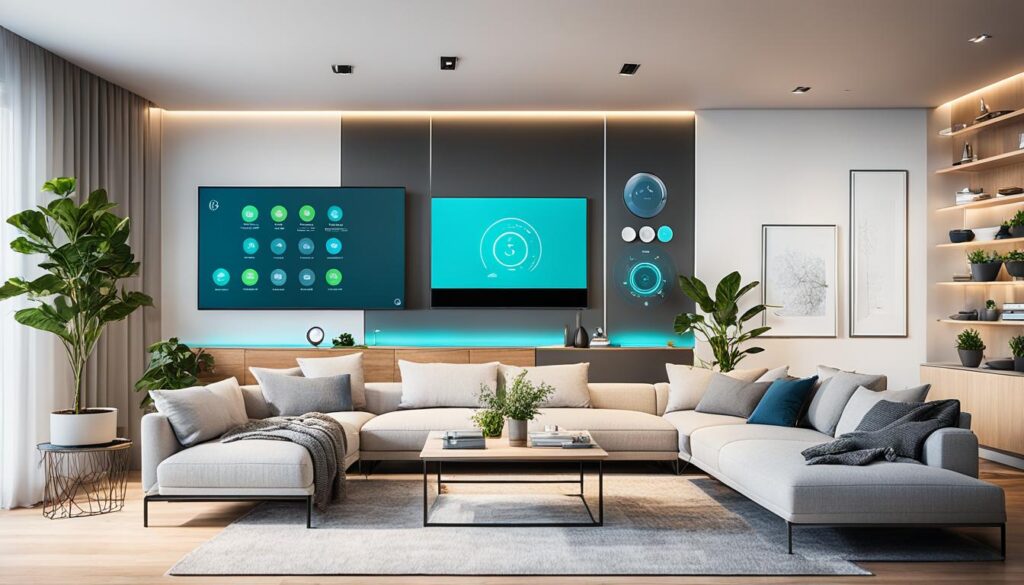
How IoT in Smart Home Works
The Internet of Things (IoT) has changed how we live in our homes. It lets us connect devices and sensors to make our spaces smarter. This setup includes smart devices, sensors, and a main hub. They work together for better control and personal touch.3
Device Connectivity
Devices in smart homes use different wireless methods, like Wi-Fi and Bluetooth. This allows them to talk to each other easily. Each method has its own range and reliability. For instance, Z-Wave can reach up to 30 meters. This is more than Zigbee, which covers just 10 meters.2
Data Collection and Transmission
Sensors are at the core of how smart homes work. They gather lots of data, like movement and light levels.3 This info then goes to the main hub. That’s usually through the internet. It helps the system make smart choices and do things automatically.
Central Hub Processing
A special central hub does a lot of the thinking in a smart home. It takes the data from sensors and figures out what to do. It can follow pre-set rules or what you want.6 This central control is key to a smooth-running smart home.
Automation and Control
IoT makes it possible for homes to take care of themselves in many ways. For example, if a sensor notices you’re not home, it can turn off lights.6 It can also adjust the temperature or close the blinds. This leads to saving energy, being safer, and making life easier.
User Interaction
IoT makes homes easy to control. You can use your voice with assistants like Amazon Alexa.3 Or you can use apps and websites. These controls help you manage devices, set preferences, and keep an eye on your home, no matter where you are. It makes living smarter and tailored to you.
Bringing IoT into homes is a big achievement. It combines tech, sensors, and automation for a better living space. As IoT grows, we’ll see smarter and simpler ways to enjoy our homes more. This means more comfort, saving energy, and settings that fit our lives just right.
iot smart home Technologies
Today, our homes can be transformed into smart spaces. This happens thanks to IoT technologies. These innovations support connectivity, automation, and advanced features. Smart sensors, voice assistants, and smart appliances are key. They play a big role in shaping smart homes.21
Smart Sensors
Smart sensors are crucial in making homes smart. They collect and send data in real time. Sensors keep track of temperature, humidity, light, motion, and air quality.1 The data they gather helps smart home systems make automatic adjustments. This leads to better comfort, energy use, and safety.
Voice Assistants
Voice assistants, like Amazon Alexa and Google Assistant, are now common. They help manage the home by listening to voice commands.1 These AI devices control many functions. They make it easy to turn lights on or off and adjust the thermostat. Voice assistants also work with other smart home gadgets. This makes managing the home smoother.
Smart Appliances
Appliances like fridges, washing machines, and ovens can be part of a smart home. They connect with other devices and can be controlled from afar.1 These machines share live data on how they’re used and their energy use. This data helps homeowners run their homes better.
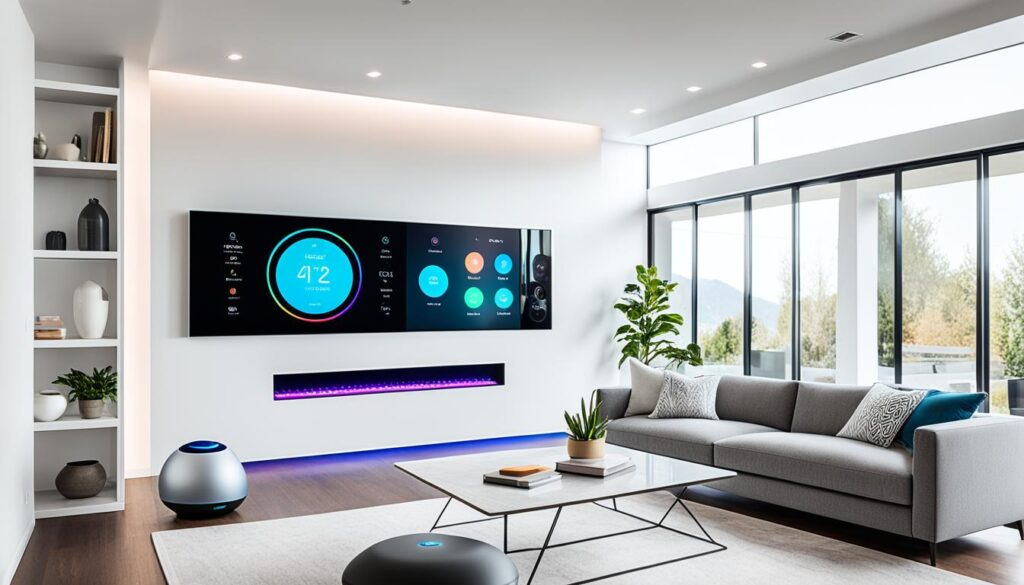
Benefits of IoT in Smart Homes
IoT brings many benefits to our homes. It makes life easier, safer, and more efficient. Homeowners can enjoy customized features too.3
Convenience
With IoT, running a home is smoother. You can control various systems from anywhere. This means less work for you and more efficient energy use. Smart features handle tasks automatically.1
Enhanced Security
IoT boosts home security through smart systems. Cameras, locks, and motion sensors work together. They alert you to problems and let you check in from afar.3 This real-time protection keeps homeowners feeling safe.1
Energy Efficiency
IoT helps save on electric bills by managing energy smartly. By analyzing usage and user habits, it adjusts energy needs. This makes smart devices more eco-friendly.3 They help cut down on energy use.1
Personalization
Smart devices cater to your unique needs. They make your home truly yours. Sensors learn about your environment and tailor it to you.1 This makes living spaces more comfortable.3
Voice assistants and smart appliances are key in these homes. They offer hands-free help and interact with the central system.3
Looking ahead, IoT will connect even more devices. AI will make homes smarter. We’ll see more IoT uses and a focus on keeping data safe.3
Challenges and Considerations
The push for iot smart home tech brings lots of good. But, it also brings big issues. We face data security, privacy worries, and getting all our devices to work together well. These are key for a lasting home automation and connected devices dream.
Data Security and Privacy
Iot smart home gadgets raise big concerns about keeping our data safe and private. These connected devices can pick up a ton of personal info. Think patterns, fingerprints, and even video or sound clips. It’s super important to lock down this info to prevent info theft, hacking, or privacy intrusions. Solving these data worries is key to earning people’s trust in home automation.
Interoperability
The world of iot smart home is full of different devices and languages. Making them work together smoothly is no simple task. When things don’t talk to each other, or we can’t control them, it can be really frustrating. Tackling this problem means we get to use cool features like voice control better and make our homes more intelligent.
Reliability
Can we trust iot smart home systems to keep our homes running right? They manage things like security monitoring and lights. If they hiccup, it could mess with our safety. Making sure these systems are always on point is crucial for us to actually trust this tech in our homes. Building trustworthy connected devices is key to making iot at home a success.
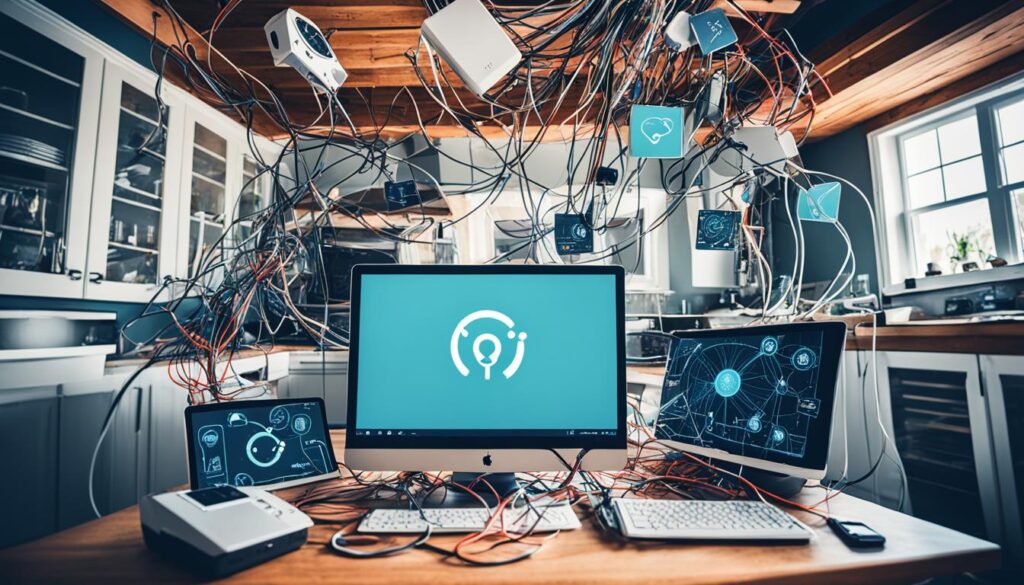
There’s a lot to do to keep iot smart home tech moving forward. Top priorities include securing our data, getting all devices to work together, and making dependable systems. By focusing on these big challenges, we make home automation better. This gives us homes that are truly intelligent, making life more convenient, efficient, and peaceful.7
Setting up an IoT Smart Home
Setting up your IoT smart home varies. It depends on your home’s stage and the smart tech you want.
Newly built homes might have smart tech built into them already. This makes setting up easier.8But, if you live in an older home, you can still go smart. You can add smart devices and technologies to turn your place into one that’s intelligent and connected.
Start by looking into home automation protocols. These are like the languages smart devices speak. Types include Zigbee and Z-Wave. There’s also the newer Matter standard that’s becoming more popular. These protocols help smart devices talk to each other without issues.8
You can build your smart home system step by step. Use gadgets like Arduino or Raspberry Pi. Or, pick ready-to-use smart home kits. These kits have everything you need, from a hub to devices like smart lights, thermostats, and cameras.
Whichever way you choose, making sure everything works together is key. This ensures a smooth experience. Picking the right devices and tech lets you make a smart, responsive, and efficient home. This not only makes life easier but also better.8
Smart Home Ecosystem Integration
The smart home world goes further than just our living spaces. It connects with bigger plans like making cities smarter too.9 This is great news for our planet because smart houses help make city life more sustainable.10
Thanks to the Matter protocol, over 5.5 billion smart home gadgets will be shipped by 2030.10 This means our smart gadgets at home will connect more with city-wide initiatives. It’s all about making your life better and greener.
Expansion of IoT Ecosystem
The world of IoT is getting bigger, with devices for every part of home life.11 This means more convenience and efficiency for you. You’ll be able to control lots of different smart gadgets all at once.
Platforms like Intertrust support thousands of controllers and millions of activity logs.9 They really want to make a secure and trusted place for IoT data. It’s all about keeping your information safe.
New solutions are coming to make Matter-enabled homes work better and safer.10 Adding AI to your smart home can make things even easier.10 With AI, your home will start to understand what you like and do things for you. It’s like having a house that knows you well.
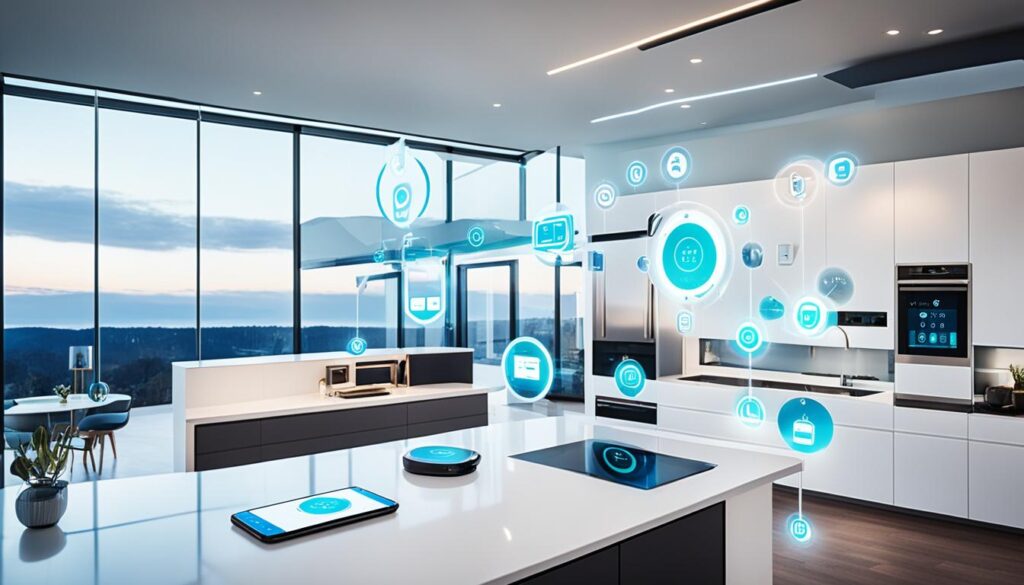
The Future of IoT in Smart Homes
The future of IoT in smart homes is very bright. We will see new technologies and ideas that change how we live. These changes will make our homes smarter and more useful than ever.
Artificial Intelligence Integration
The use of Artificial Intelligence (AI) is a big step forward. AI will help smart devices learn and adapt to how we live. This means our homes will know what we need and make things easier for us.
Enhanced Security
Home security will be better than we’ve ever known. With the help of AI, our homes will keep us safer. They’ll have smart locks and cameras that work together to protect us.
Improved Interconnectivity
Touching on , our homes will talk to each other and the world. This will make everything work smoothly together. We’ll be able to control our homes from anywhere with ease.
The potential of smart homes is vast. They will be more integrated, secure, and interconnected. These changes will make our home lives better and simpler. The future will bring us homes that truly understand and meet our needs.
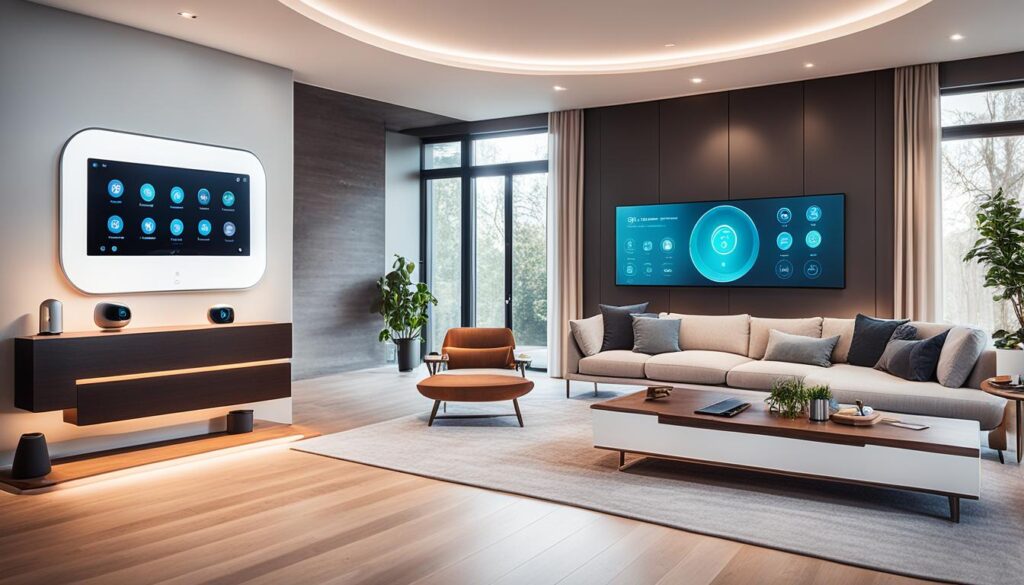
Conclusion
The Internet of Things has turned regular houses into smart homes. It gives people better control, ease, and saves energy.1 With time, new smart features will make these homes even more helpful. This includes using Artificial Intelligence (AI) to run things smarter. Plus, there will be stronger security, thanks to AI learning to find and stop threats.
At first, setting up IoT in your home might seem pricey. But, as more people use it, the cost goes down. This means it’s becoming more affordable. The smart home trend is changing how we live. The future for smart homes is exciting. It will make our homes adapt to us, making everything work better and fit our lives perfectly.1
Smart homes and cities will work together better in the future. This will help make urban life more eco-friendly. Also, as IoT grows, it’ll improve our health, cooking, and how we enjoy our homes. Smart homes will adjust to what we need, offering us the best living experience.
FAQ
What is a smart home?
A smart home uses internet-connected devices for remote monitoring and managing home systems. This includes lighting and heating. Homeowners can control these devices with a smart home app on their phone or another device. This technology brings security, comfort, and energy efficiency.
How does IoT (Internet of Things) enable smart home technology?
IoT connects devices and a hub in smart homes. This network allows for easy communication and control of the home.
What are the key applications of IoT in smart homes?
IoT in smart homes is used for automation, security, energy efficiency, entertainment, and health.
What IoT technologies are commonly used in smart homes?
Common IoT technologies in smart homes are smart sensors, voice assistants, and smart appliances. They help connect and automate your home.
What are the benefits of IoT in smart homes?
Integrating IoT in smart homes brings many benefits. This includes convenience, security, energy savings, and personalized experiences.
What are the challenges and considerations with IoT in smart homes?
Some challenges with IoT in smart homes are privacy and security of data, devices working together, and their reliability.
How can I set up an IoT smart home?
There are several ways to set up an IoT smart home. You can choose a new home that’s already smart or add smart tech to older homes. Common protocols for smart homes include Zigbee, Z-Wave, and Matter.
How is the smart home ecosystem integrated with broader initiatives?
Smart homes connect with larger projects like smart cities. As the IoT grows, smart homes will help make urban living more sustainable.
What is the future of IoT in smart homes?
The future of IoT in smart homes is bright. More tech and better security are coming. Costs are dropping, making smart homes more popular.
Source Links
- https://iotbusinessnews.com/2023/11/10/89810-the-smart-home-revolution-how-iot-is-transforming-modern-living/
- https://www.techtarget.com/iotagenda/definition/smart-home-or-building
- https://scand.com/company/blog/internet-of-things-in-smart-home/
- https://www.analyticssteps.com/blogs/9-applications-iot-home-automation
- https://www.xenonstack.com/blog/iot-application-smart-home
- https://www.sam-solutions.com/blog/iot-home-automation/
- https://aumraj.com/challenges-of-iot-in-smart-home-automation/
- https://www.wired.com/story/how-to-set-up-smart-home/
- https://www.intertrust.com/markets/smart-home/
- https://www.forbes.com/sites/forbestechcouncil/2024/01/08/from-chaos-to-clarity-how-the-matter-protocol-brings-order-to-the-smart-home-ecosystem/
- https://www.vectorsecurity.com/blog/the-smart-home-ecosystem
